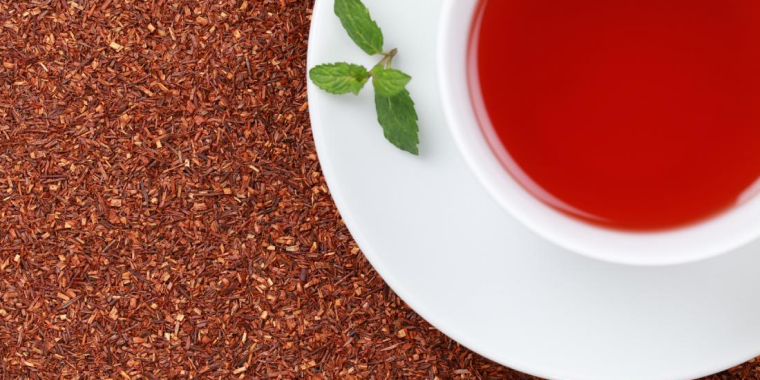Rooibos Tea
Rooibos (pronounced ‘roy-boss’) is a shrub-like bush native to South Africa. While it’s often referred to as a tea, rooibos is in...

Rooibos (pronounced ‘roy-boss’) is a shrub-like bush native to South Africa. While it’s often referred to as a tea, rooibos is in fact a herbal infusion. For centuries, rooibos has been used in its homeland for its many purported medicinal purposes, but we like it at any time of day because it is naturally caffeine-free.
Rooibos tea (which translates as ‘red bush’ tea) comes from the shrub Aspalathus linearis, whose leaves are long and needle-like. Once harvested and dried, they are fermented into a reddish-brown herbal infusion, hence the name.
Rooibos is grown in South Africa’s Western Cape region, and while farmers have tried to grow it in other parts of the world, the climate, soil and conditions are optimal in South Africa. In fact, in 2014, rooibos received Geographical Indicator (GI) status – similar to products such as Parmesan, Champagne and Port – which means it can only be called rooibos if it’s sourced from the defined area in the Cederberg and surrounds.

HOW ROOIBOS TEA IS MADE?
The production of rooibos tea is a fascinating process: the plant is cut by hand and then bruised to encourage oxidisation, which helps develop its rich colour and woody, caramel flavour. As oxidisation occurs, the rooibos becomes a richer shade of red.
While other styles of tea may be an acquired taste for some, rooibos’ mild flavour profile, with its sweet notes of honey and vanilla, make it among the most palatable teas available, and increasingly popular with tea drinkers around the world.
WHAT ARE THE BENEFITS OF ROOIBOS TEA?
For centuries, South Africans have used rooibos for a variety of purported health benefits as outlined here by the Rooibos Council. In fact, it’s reported that a third of South Africans drink rooibos as part of their cold and flu fighting arsenal.
While other styles of tea may be an acquired taste for some, rooibos’ mild flavour profile, with its sweet notes of honey and vanilla, make it among the most palatable teas available, and increasingly popular with tea drinkers around the world.
Here are some of the benefits of rooibos tea:
Good Source of Antioxidants
Rooibos contains several antioxidants. In one 15-person study, blood levels of antioxidants increased by 2.9% when participants drank red rooibos and 6.6% when they drank the green variety. This uptick lasted for five hours after the participants drank 500ml of tea made with 750mg rooibos tea leaves. With 50% more antioxidants than green tea, rooibos tea is often chosen as a preferred drink due to its high antioxidant composition. Rooibos also contains low amounts of tannins, the astringent, bitter-tasting plant polyphenols that bind and precipitate proteins and interfere with iron absorption in the body.
Naturally caffeine-free
Rooibos tea is free from caffeine, which may make it a good option for pregnant people, children, and those who are sensitive to caffeine. Caffeine is present in black tea, green tea and coffee. Rooibos tea is a good alternative for people who would like to reduce their intake of caffeine or avoid it completely.
Digestive Wellbeing
Rooibos tea contains several nutrients that are antispasmodic. A study published in the Basic & Clinical Pharmacology & Toxicology Journal showed that compounds such as quercetin, orientin and vitexin, which are present in rooibos, can help relax the digestive system and relieve feelings of discomfort
IS THERE CAFFEINE IN ROOIBOS TEA?
There is no caffeine in rooibos tea, which is why it can be enjoyed at any time of day by people of all ages. Many South African children grow up accustomed to the taste of rooibos tea as it has been used by generations of mothers who swear by its ability to relieve teething gums or soothe colicky babies.
HOW DO YOU DRINK ROOIBOS TEA?
How you drink rooibos tea very much comes down to personal preference. The mild, aromatic taste is quite sweet, with hints of vanilla, caramel and honey, so you can drink it just as you would any other black or green tea. Some prefer it plain, or others like to add a little milk and even a swirl of honey.
Recently, rooibos tea has been used as a core ingredient in a number of different styles of hot and cold drinks – from lattes, to iced teas, mocktails and even cocktails.
WHAT IS THE BEST ROOIBOS TEA?
Good rooibos tea can be hard to find. Luckily for Australian tea drinkers, Nerada makes a delicious Rooibos and Vanilla Tea that can be found in major supermarkets such as Coles and Woolworths, along with many independent grocery stores. It’s Rainforest Alliance certified and pesticide-free.
To bring out the naturally warm, sweet notes of rooibos, we have added a hint of vanilla to the tea.
Discover Nerada Rooibos and Vanilla Tea here
Discover Nerada Rooibos - 50 Tea Bags here
Discover Nerada Rooibos & Honeybush - 50 Tea Bags here
Disclaimer – Please note that while any information given in regards to the health benefits of rooibos is backed by scientific study, we recommend consulting with a medical practitioner if you have any specific health questions.
